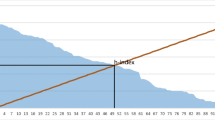Abstract
This paper presents the results of an evaluation of the national research system in Morocco. The exercise focuses on the period 1997–2006 and includes a comparison with South Africa, Egypt, Nigeria, Tunisia, Algeria, Portugal and Greece. Ratings of highly ranked researchers are developed on the basis of their number of publications, number of citations and also their ‘h-index’ (or Hirsch index). Finally, we examine the empirical model set by Glänzel that related the h-index to the number of publications and the mean citation rate per paper for these ‘upper-class’ researchers. The use of this model confirms that the h-index is likely to reflect the importance and the quality of the scientific output of a given researcher.
Similar content being viewed by others
References
Arnold, E. (2004), Evaluating research and innovation policy: a systems world needs systems evaluations, Research Evaluation, 13(1): 12–13.
Bornmann, L., Daniel, H.-D. (2005), Does the h-index for ranking of scientists really work?, Scientometrics, 65(3): 391–392.
Csajbók, E., Berhidi, A., Vasas, L., Schubert, A. (2007), Hirsch-index for countries based on Essential Science Indicators data, Scientometrics, 73(1): 91–117.
Egghe, L. (2006a), Theory and practise of the g-index, Scientometrics, 69(1): 131–152.
Egghe, L. (2006b), An improvement of the h-index: The g-index, ISSI Newsletter, 2(1): 8–9.
Glänzel, W. (2006). On the h-index — A mathematical approach to a new measure of publication activity and citation impact, Scientometrics, 67(2): 315–321.
Hicks, D., Tomizawa, H., Saitoh, Y., Kobayashi, S. (2004), Bibliometric techniques in the evaluation of federally funded research in the USA, Research Evaluation, 13(2): 81–84.
Hirsch, J. E. (2005), An index to quantify an individual’s scientific research output, Proceedings of the National Academy of Sciences, 102(26): 16569–16572.
Iglesias, J. E., Pecharroman, C. (in press), Scaling the h-index for different scientific ISI fields, www.ArXiv.org.
Katz, J. S. (2000), Scale-independent indicators and research evaluation, Science and Public Policy, 27(1): 23–36.
Katz, J. S., Hicks, D. (1998), Indicators for systems of innovation — a bibliometrics-based approach, IDEA Paper Series, 12: 4–6.
Louise, F. D., Goodman, D. (2004), Web of Science (version 2004) and Scopus (2005), Charleston Adviser, 6(3): 25.
Martin, B. R., Irvine, J. (1983), Assessing basic research: some partial indicators of scientific progress in radio astronomy, Research Policy, 12: 65–69.
Martin, B. R. (1991), Performance indicators for assessing British university research, In: H V. Wyatt (Ed.), Festschrift Volume in Honour of Dr I. N. Sengupta.
MRSM (2003), Evaluation du Système National de la Recherche Scientifique et Technologique, Ministère chargé de la Recherche Scientifique du Maroc.
Narin, F. (1987), Bibliometric techniques in the evaluation of research programs, Science and Public Policy, 14(2): 104–106.
OECD (1987), Evaluation of Research: A Selection of Current Practices, Paris. pp. 32–37.
Quoniam, L., Rostaing, H., Boutin, E., Dou, H. (1995), Treating bibliometric indicators with caution: their dependence on the source database, Research Evaluation, 5(3): 179.
Rousseau, R. (2006), New developments related to the Hirsch index, (electronic working paper, KHBO (Association K.U.Leuven), Industrial Sciences and Technology, Zeedijk 101, 8400 Oostende, Belgium); published in Science Focus, 1(4): 23–25 (in Chinese).
Schubert, A., Glänzel, W. (2007), A systematic analysis of Hirsch-type indices for journals, Journal of Informetrics, 1: 179–184.
Vanclay J. K. (2006), On the robustness of h-index, Journal of the American Society for Information Science and Technology, 58(10): 1547–1550.
van Raan, A. F. J. (2006), Comparison of the Hirsch-index with standard bibliometric indicators and with peer judgment for 147 chemistry research groups, Scientometrics, 67(3): 491–502.
Author information
Authors and Affiliations
Corresponding author
Rights and permissions
About this article
Cite this article
Bouabid, H., Martin, B.R. Evaluation of Moroccan research using a bibliometric-based approach: investigation of the validity of the h-index. Scientometrics 78, 203–217 (2009). https://doi.org/10.1007/s11192-007-2005-4
Received:
Published:
Issue Date:
DOI: https://doi.org/10.1007/s11192-007-2005-4




